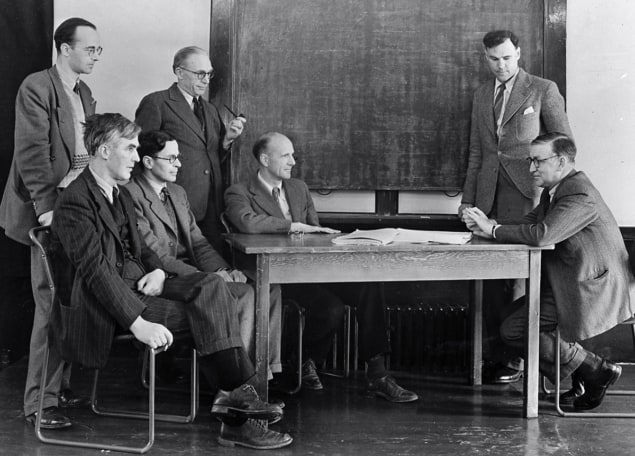Margaret Harris reviews Trinity: the Treachery and Pursuit of the Most Dangerous Spy in History by Frank Close

In the spring of 1941, Rudolf Peierls was in a bind. The British effort to develop atomic weapons, in which he played a leading role, was chronically under-resourced. The UK’s military situation, though somewhat improved compared to the darkest days of 1940, remained precarious. And as a Jewish refugee from Nazi Germany, Peierls had more reason than most to fear what would happen if Adolf Hitler’s scientists got the Bomb before Winston Churchill’s. So when a talented young physicist – a fellow refugee who shared many of his ideals, and got on well with Peierls’ wife and children – came to join his research group at the University of Birmingham, Peierls must have seen him as the answer to a prayer.
There was just one problem. Peierls’ new assistant was Klaus Fuchs, a committed Communist who was probably already contemplating espionage by the time he arrived in Birmingham. Over the next seven years, during which Fuchs held a string of positions within the British and American atomic bomb projects, knowledge of this top-secret work flowed from him to Moscow, and thence to Soviet scientists who used it to jump-start their own weapons programme. Frank Close, whose new book Trinity focuses on Fuchs’ story, calls him “the most dangerous spy in history”, and he was certainly one of the most successful, passing hundreds of pages of atomic secrets before he was finally caught.

The Einstein File: J Edgar Hoover’s Secret War Against the World’s Most Famous Scientist
Fuchs’ double life has all the trappings of a Cold War spy thriller, complete with dead drops, murky motives and secret rendezvous. It even has a beautiful and bigamously married young woman codenamed “Sonya” who passed information from Fuchs to the Soviet embassy after meeting him for (platonic) assignations in the Oxfordshire countryside. Alas, to compare Trinity to “a novel by le Carré”, as the physicist and writer Jeremy Bernstein does on the book’s dust jacket, would be a discourtesy to the master of Cold War spy fiction. At 425 pages plus copious endnotes, bibliography and appendices, Trinity is not a quick read, and in places it is also a frustrating one.
A major source of this frustration is Close’s tendency to repeat himself. On page 162, for example, he informs his readers that, after the war, “Fuchs returned to England in a British bomber”. A few paragraphs later, and referring to the same journey, he states that Fuchs “flew by air-force plane to England”. On its own, a slip such as this would be too trivial to mention. In a long document, it is easy for writers to lose track of what they have and have not explained, or to unwittingly repeat a memorable phrase (such as referring to a nuclear reactor as a “heat engine” or describing a particular mistake as having “led to Fuchs’ downfall”, both of which Close does at least twice). But this is not an isolated incident, and the pattern, once noticed, is hard to un-see.
We are twice told that shadowing someone is not as smooth a process as it is portrayed in films; that Fuchs, in his eventual confession to the British security services, confused a location near Hyde Park with one near Hampstead Heath; that his subsequent arrest led his colleague Bruno Pontecorvo to defect; that the Democrats had controlled the US presidency for 20 years by the time the scandal broke; and that, by moving to East Germany after nine years in a British prison, Fuchs fulfilled the German Communist party’s pre-war hopes that technically minded people would return to build a new socialist utopia.

A case of mistaken identity
The reader is also told at least four times that James Chadwick discovered the neutron, and twice (on adjacent pages) that G P Thompson’s insights about breeding plutonium in a uranium reactor led to his research being classified as secret. And when one finds, on page 141, an explanation of a concept – critical mass – that has already been described or referred to on pages 125, 130 and 134, one starts to feel that the book’s repetitions have reached a critical mass of their own, as minor flaws tip over into a more substantial fault.
It doesn’t help that Close uses footnotes to discuss aspects of the story that haven’t happened yet. Sometimes, these footnotes state that the topic in question is covered in more detail in a later chapter; on one occasion, a footnote refers back to an explanation (of electromagnetic separation of uranium isotopes) given a mere four pages previously. The unfortunate effect of this foreshadowing (and backshadowing) is to snap the reader out of Fuchs’ story, draining some of the tension from it in the process.
That’s a shame, because there is otherwise much to appreciate in Trinity. The book’s later chapters, covering the months leading up to Fuchs’ confession and arrest, are taut and suspenseful. Close also deals well with the political tensions that underlay the wartime alliance between the UK and US, which inhibited co-operation between scientists and security services alike. Thanks to American restrictions on information-sharing, some of Fuchs’ spying was, in effect, done for the British as much as for the Soviets. This fact, Close argues, may have shaped Fuchs’ naïve belief that he could continue working in the UK after he made a clean breast of his covert activities.

Tinker, tailor, physicist, spy?
From a physics standpoint, Close’s description of Fuchs’ scientific work is cogent and helpful, particularly in the later stages of his career, which was spent at the UK’s nascent atomic-weapons research facility in Harwell, Oxfordshire. This work proved so important to the development of the British atomic and hydrogen bombs that Close speculates that Fuchs might well have been knighted for his services, if only his espionage had gone undetected. It’s an intriguing idea, and one suspects the author of Tinker, Tailor, Soldier, Spy would appreciate the suggestion that the line between hero and villain is sometimes finer than we like to think. In this respect, the comparison to le Carré is fully merited.
-
2019 Allen Lane £25.00hb 528pp



